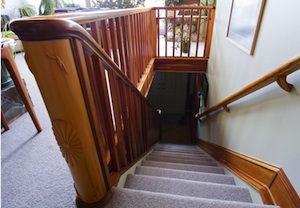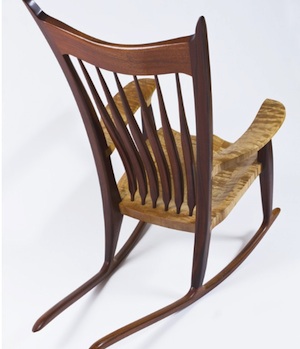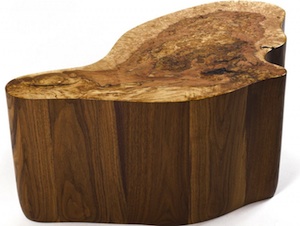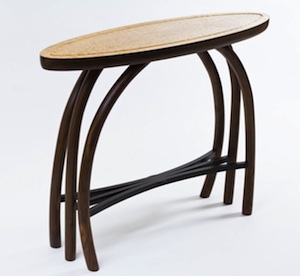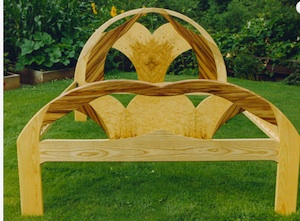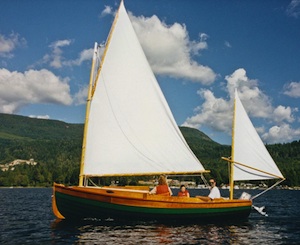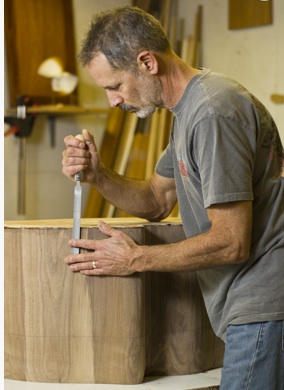
Back in the early 1980s, Jim Slakov was a young man looking for a construction or carpentry apprenticeship — and not finding one anywhere near his hometown of Vancouver, British Columbia. “There was a pretty serious recession at the time,” he said.
So, Jim decided to go north to the Yukon Territory to seek work – and, on the way, he met someone who suggested he sign up for an apprenticeship program there. It avoided the five-year waiting list he was facing in the Vancouver area. Only problem? That year, there was no house to build in the Yukon program. With access to the machines and some woodworking books, however, Jim started practicing skills he could use. “It was a self-learning thing,” he said.
“I’ve learned all my woodworking from pictures and books,” Jim said. “I haven’t taken any classes; I haven’t had any training. It’s all self-taught: I just beat my head against the wall” until he learns a skill.
Ironically, despite his grandfather working in the construction industry – his company built the Vancouver city hall – and building furniture in his basement workshop, Jim grew up in a family where, “if you didn’t go into one of the ‘professions,’ you were looked down upon.” That, he says, is the explanation for why he failed woodworking in high school: “I was one of the kids who was goofing around in class; we’d saw people’s projects in half. I was a pretty terrible kid in that class.”
Despite such unpromising beginnings in woodworking, Jim has made his living since the mid 1980s building high-end kitchens, other built-in woodwork, such as fireplace mantels and staircases, and furniture. His influences, he says, have come from pictures of the works of such woodworkers as Sam Maloof, or Wendell Castle. Jim made a Maloof-inspired rocking chair, “but spent a lot of time making it my own,” he said, including using dovetailed joinery. He also admired Maloof’s “practical approach, sort of his attitude of ‘use whatever tool will get the job done.'” As for Wendell Castle, it’s the organic shapes of Castle’s earlier works that have influenced Jim. “I was trying to get the feel of a simple base for a table from one of those,” he said.
Lately, Jim has been making tables with the top joined to the sides. “It’s an incredible amount of hours to figure out how to jig it up, and you end up having to throw the templates away. You can’t use ’em twice.” When he first began woodworking, Jim said, “Back in those days, everything was dovetailed.” These days, he’s working with this hidden miter technique, “making template after template and changing the size of them, changing router bits … I like the results of it.”
Jim says he also likes Shaker style, because “it goes with curves, French style, farm style, whatever clients want.” As for wood choices, he likes to use local big-leaf maple, but it’s in high demand for applications like musical instruments and gunstocks, and can sometimes be hard to come by. He also likes black walnut, mahogany and cherry, and wenge for an accent wood. “Here on the West Coast, we don’t have any hardwoods to speak of,” Jim said. It was easier to get pieces of different woods when he was doing a lot of veneering several years ago, but these days, “I want to stick with solid wood.” For example, “With quilted maple, why would I want to get veneer when I can get a 3″ solid burl?”
Anyway, when it comes to doing a project, “Half the fun is getting a wood pile and digging through it,” he said.
One of his particularly fun projects was a sailboat he built for himself, the Kelani Rose, which won first prize in the Vancouver Wooden Boat Show the year he launched it. Jim built a shop for the boat in the backyard behind his “real” shop, and worked on it for a couple of years in his spare time. “I’d already been building cabinetmaking stuff for 18 to 20 years or so when I built the boat, so I used those skills. I’d always done a lot of curved joinery, and it’s all one and the same when you’re working with wood – there’s no fiberglass on that boat.”
For others who are just starting out working with wood, Jim said, “If I had one thing to say, it would be to take pictures as you go: otherwise, you lose it all” – he doesn’t have photographs, he estimates, of probably 70 percent of the projects he’s built over the years. And, while those have often involved kitchens, after this year’s two big installations, Jim says he’ll be focusing on furniture only. “I turned 60 last November, and it’s a lot of lifting and stuff installing a kitchen by yourself,” he said.
